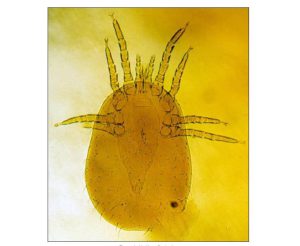Poultry pest management is an important topic for backyard chicken owners. Lice and mites are the most common poultry pests in Florida. Fleas can also pose an issue to your flock. Understanding the basics about these pesky external parasites is key. Here’s what you need to know to keep your backyard chickens healthy…
What is an external parasite? An external parasite is an organism that lives on or in a host, in this case – a chicken. The parasite feeds off of the chicken causing it stress, illness, decline in production, and if not treated, can potentially lead to death.
How do external parasites affect poultry? The parasite sucks the blood from the host or feeds on the feathers and/or skin. Depending on the parasite, certain diseases can be transmitted while feeding.
COMMON EXTERNAL PARASITES IN FLORIDA BACKYARD CHICKENS:
Northern Fowl Mites:
The Northern fowl mite is a very common external parasite on poultry throughout the temperate regions. The mites live mainly on the chicken around the vent, but will also roam to the eggs and coop. These parasites are more common during winter months, specifically December through March. They can be transmitted from bird to bird, by adding new birds infested by mites to the flock, by wild birds, and by mites crawling to their new host from the environment. Be sure to quarantine any new birds before introducing them to your flock.
It is important to be observant of your birds’ health. A few mites on the birds will be more of a nuisance to the handler than the bird. On the other hand, large quantities of mites can cause reduced egg production, reduced feed intake, weight loss, anemia, or even death. Mite populations can increase substantially within just a few weeks of initial infestation. If you see any symptoms including scabbing of the skin, darkened feathers, and a pale comb, you should check your chickens for Northern fowl mites and take appropriate treatment measures.
Control Method– Use an appropriate insecticide that is labeled “For Use on Poultry.” Nothing kills the eggs, and it takes about a week for eggs to hatch. As a result, insecticide should be reapplied in 4-7 days to control newly hatched mites. But first – READ AND FOLLOW THE LABEL INSTRUCTIONS – some insecticides cannot be applied as often.

Sticktight Fleas:
Sticktight fleas are a common problem in Florida. They can live on other animals, such as dogs, cats, and horses. The fleas can be found in clusters on the comb and wattles, on the skin around the eyes, and bare patches of infested birds. It’s quite small – only about ½ the size of a typical cat flea. Since they come in clusters, they are relatively easy to see on your chickens.
The sticktight fleas feed on the blood of the bird. Fortunately, they are not known to transmit disease. Be on the lookout for secondary infections that can cause eyes to swell shut, birds to starve to death, and young animals to be anemic. Reduced egg production is one of the most common symptoms.
Control Method – If fleas are too numerous to remove individually, a flea insecticide registered “For Use on Poultry” should be applied according to label instructions. Care should be taken not to get any product into the animal’s eyes. The coop should also be treated. An alternative to on-animal insecticides is to coat adult fleas in petroleum jelly. This suffocates the fleas, eventually killing them. Since this does not treat the eggs, repeat treatment weekly to kill newly hatched fleas until control has been reached.

Poultry Lice:
Poultry lice are a species specific biting lice. Blood sucking lice do not occur on birds. Lice are often found on backyard chickens, especially ones that hatch and raise chicks – passing the louse from the hen to the chick. You can find lice feeding on the barbs and scales of feathers, feather fibers, down, skin, scabs, and protective sheaths of feathers. Be on the lookout for birds showing signs of itchiness, skin irritation, damaged plumage, and bare skin. It is common to see poor condition and reduced egg production in older birds. Young birds often exhibit secondary infections, resulting in death.
Types of lice – The shaft louse, the fluff louse, the wing louse, and the chicken head louse are the most common lice on poultry in Florida.
- Shaft Louse – The most detrimental louse pest for chickens. It can be found feeding on the barbs and scales of feathers. They can be found on the feathers.
- Fluff Louse – Can be found living in and feeding on the fluff under the vent.
- Wing Louse – Can be found on young and old chickens on the barbules of wing feathers.
- Chicken Head Louse – Often infests the head and neck of chickens.
Control Method – Lice typically stay on the bird, so treating the coop is of little value. Controlling lice can be achieved through applying sprays or dusts directly to the bird. Be sure to use a product labeled for poultry and follow the label instructions.

Summary
Several other pests may infest your backyard chickens. Being observant to changed behavior and health conditions, paired with timely pest identification and treatment is important. Always be sure to read and follow label instructions before applying any insecticides. Creating a biosecurity plan can also prove useful for protecting your flock’s health. For more information on Backyard Chicken Biosecurity, check out the Backyard Chickens: Biosecurity blog, the External Parasites of Poultry publication, or contact your local Extension Agent, Allie Williams at allisonwilliams@ufl.edu
 0
0
